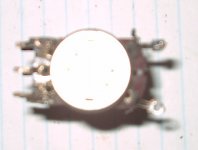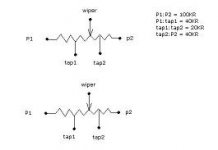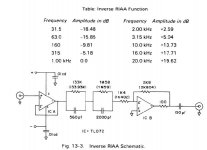i am repairing this receiver i got at a yard sale some time ago. got both channels on the amp board working good and sounding very nice (one was toast), but the volume pot turned out to be scratchy (surprise, surprise). i pulled it out and saw something strange, for me at least.
this is a typical dual ganged 100K stereo pot, but it has TWO loudness taps PER CHANNEL (4 total) on the bottom (see attached). in other words, measuring on one channel only with the pot removed, working clockwise, i have ~40K between the left terminal and the first tap, ~20K between the two taps, and ~40K between the second tap and the rightmost terminal. each of the taps had a separate wire running from it back to the tone controls board the vol pot was mounted on.
my questions are ... anyone know of a suitable replacement? i do have a 100K dual ganged but with only one tap per channel at 40K. could i use this and just hook the two wires from the tone control board (for each channel) that used to go to the separate taps together onto this one tap? or could i just leave the taps disconnected and not use the loudness switch? i also noticed this receiver appears to have a switch that boosts the treble ... perhaps what the second pair of taps are for?
as always any help greatly respected. i am so close to having this baby working and on my shelf i hope this is something that can be worked around.
this is a typical dual ganged 100K stereo pot, but it has TWO loudness taps PER CHANNEL (4 total) on the bottom (see attached). in other words, measuring on one channel only with the pot removed, working clockwise, i have ~40K between the left terminal and the first tap, ~20K between the two taps, and ~40K between the second tap and the rightmost terminal. each of the taps had a separate wire running from it back to the tone controls board the vol pot was mounted on.
my questions are ... anyone know of a suitable replacement? i do have a 100K dual ganged but with only one tap per channel at 40K. could i use this and just hook the two wires from the tone control board (for each channel) that used to go to the separate taps together onto this one tap? or could i just leave the taps disconnected and not use the loudness switch? i also noticed this receiver appears to have a switch that boosts the treble ... perhaps what the second pair of taps are for?
as always any help greatly respected. i am so close to having this baby working and on my shelf i hope this is something that can be worked around.
Attachments
I'm pretty sure you can stick it in there without problems -
if not, nothing lost except a little labor.
if not, nothing lost except a little labor.
Mr. Pass, thank you for your reply. this 4-tap pot was the one i pulled out (the original), so does this mean its ok to replace it with one with fewer or no taps and just leave the original connections going to the original taps disconnected?
many thanks again especially for all your contributions to diy audio!!!
many thanks again especially for all your contributions to diy audio!!!
gain said:here is a diagram of the device i pulled out to make it more clear. both tap1 and tap2 are connected into the tone control circuit.
thanks.
just find similar pot and mount it ;
if new pot have loudness tap , measure his position in overall resistance , then solder on it line in similar position of original pot .
redundant one ( second loudness line ) just leave disconnected .
in case that you have just plain volume pot , leave disconnected all these loudness wires and everything will be just fine ;
until you press any of loudness buttons ....... then you'll hear some buzz

Zen Mod said:
just find similar pot and mount it ;
thanks for your reply, zen.
thats the whole issue. i cannot find, nor know even where to look for a similar pot. pots with one tap are a rarity for me, two taps per channel i have never seen. i'm sure the vol control function would be fine without hooking up the taps, but if someone hits the loudness switch by accident and it goes 'buzz' followed by a cloud of smoke pouring out it would just put a damper on my day.
gain said:
thanks for your reply, zen.
thats the whole issue. i cannot find, nor know even where to look for a similar pot. pots with one tap are a rarity for me, two taps per channel i have never seen. i'm sure the vol control function would be fine without hooking up the taps, but if someone hits the loudness switch by accident and it goes 'buzz' followed by a cloud of smoke pouring out it would just put a damper on my day.
do not worry - it is just slight buzz in most cases .
for piece of mind - when you have it opened , just disconnect these loudness buttons from rest of circuit ;
in fact - you can always try it ( when you change a pot ) - press that button with volume on min , then rotate it slowly ........ and listen ;
been there ....... slight buzz is worse you can get ....and maybe even zero influence , depending on that circuit construction .
you could also terminate any open wires to ground through 39k resistors rather than leave them open.
btw i got a good laugh reading the title of this thread. it's a question i heard often in high school....
btw i got a good laugh reading the title of this thread. it's a question i heard often in high school....

many thanks to all. hooked up a reg 100K dual ganged vol pot and left all 4 of the taps disconnected. the stereo sounds AWESOME!!! what a difference a new pot made! before, it sounded a little muddy in the midrange and the treble was lacking. with the new pot, the treble is crisp and clear and the soundstage just came alive! not to mention the scratchyness is gone. i wish you all could be hear to hear it!
Greatful Dead, Touch Of Grey playing now.
now the only thing is it appears that my RIAA daughter board is not functioning properly. when i connect a turntable, i have to crank it to like 7 or 8 before hearing even a faint sound ... this couldn't have anything to do with the taps being disconnected, could it?
thanks again guys!!!! love this site!
Greatful Dead, Touch Of Grey playing now.
now the only thing is it appears that my RIAA daughter board is not functioning properly. when i connect a turntable, i have to crank it to like 7 or 8 before hearing even a faint sound ... this couldn't have anything to do with the taps being disconnected, could it?
thanks again guys!!!! love this site!
could be you have a different taper on the pot. volume controls use log taper, linear taper would cause what you're describing.
unclejed, good idea, but its definitely audio taper. tape, tuner, aux, etc all work fine. just the phono input is very very weak.
well, finally worked up the courage to try the loudness switch with the taps disconnected. no bass enhance effects, no buzzing, just nothing. so, i decided to do a little experimenting. connected one pair of tap wires from the tone control board to the two taps on the pot (one for each channel) and left the other pair of wires from the tone board disconnected. loudness function works great now! boosts up the bass big time and sounds smooth and clean.
could those other two wires that use to go to the second pair of taps on the original pot have anything to do with the RIAA circuit? are RIAA circuits a common failure point?
thanks to all
could those other two wires that use to go to the second pair of taps on the original pot have anything to do with the RIAA circuit? are RIAA circuits a common failure point?
thanks to all
gain said:.......
could those other two wires that use to go to the second pair of taps on the original pot have anything to do with the RIAA circuit?.....
hardly;
gain said:.......
....... are RIAA circuits a common failure point?
nope ; but electrolytic caps are, same as function switches .....
gain said:well, finally worked up the courage to try the loudness switch with the taps disconnected. no bass enhance effects, no buzzing, just nothing. so, i decided to do a little experimenting. connected one pair of tap wires from the tone control board to the two taps on the pot (one for each channel) and left the other pair of wires from the tone board disconnected. loudness function works great now! boosts up the bass big time and sounds smooth and clean.
could those other two wires that use to go to the second pair of taps on the original pot have anything to do with the RIAA circuit? are RIAA circuits a common failure point?
thanks to all
No, they were just part of the loudness compensation, probably adding additional bass boost and a little treble boost on the lower end of the volume range. Not too uncommon with Japanese and some American gear from the late 1970's.
The RIAA phono issue is something else, make sure that your receiver does not have ceramic cartridge inputs and if it does that you are not plugged into them by mistake..
 Most later higher quality models will not have this feature. More likely that there is something wrong with the phono pre-amplifier. More detail like model, schematics, etc would help. What kind of cartridge are you using?
Most later higher quality models will not have this feature. More likely that there is something wrong with the phono pre-amplifier. More detail like model, schematics, etc would help. What kind of cartridge are you using?some phono preamps have a ceramic-magnetic switch or set of jumpers. if it's set to ceramic, it won't have enough gain for a magnetic cartridge. also input stages of phono preamps can get blown if a line level input was plugged in. you can test the RIAA response with a "reverse RIAA" filter and a low level signal generator.
Attachments
ok you guys will prob get a good chuckle out of these questions as it obviously exposes my newbness when it comes to turntables. where would the ceramic/magnetic switch be and how can one tell if he is using a ceramic or magnetic turntable? i see no obvious switches on the receiver fron/back or on the RIAA board itself. there are trimpots however ...
played with it some more and found that only one channel is coming through the RIAA into the amp, and VERY weakly. if i plug the turntable into a tape/aux, i can crank it up and faintly hear both channels, so i know the turntable is putting out two channels. going through phono input gives me little more gain, but only one channel.
might just breadboard up a simple RIAA circuit and patch it in ... see if that makes my dylan record play.
might just breadboard up a simple RIAA circuit and patch it in ... see if that makes my dylan record play.
the switch is usually on the back of the receiver next to the phono input. or it could be on the phono preamp board itself (why? i don't know, but some manufacturers thought the changeover from ceramic to magnetic should be done by a service tech).
the way you check the cartridge type is to measure from center to shell on the RCA plugs with an ohmmeter. if it's a few hundred ohms it's magnetic.. if it reads open, and you know it's working, it's ceramic.
simple way to test the phono preamp is to (with the amp on, and the volume up a quarter of the way) take a paper clip with one end bent to the same shape as the tip of an RCA plug and stick it into the phono input plug. if the buzzing is really loud and bassy, it's a magnetic input. if it's not very loud with a lot of high frequency harmonics, it's a ceramic input.
the way you check the cartridge type is to measure from center to shell on the RCA plugs with an ohmmeter. if it's a few hundred ohms it's magnetic.. if it reads open, and you know it's working, it's ceramic.
simple way to test the phono preamp is to (with the amp on, and the volume up a quarter of the way) take a paper clip with one end bent to the same shape as the tip of an RCA plug and stick it into the phono input plug. if the buzzing is really loud and bassy, it's a magnetic input. if it's not very loud with a lot of high frequency harmonics, it's a ceramic input.
- Status
- Not open for further replies.
- Home
- Amplifiers
- Solid State
- Anyone know where to get some pot?



